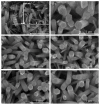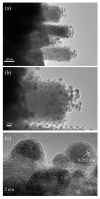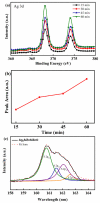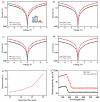Enhanced UV Photoresponsivity of ZnO Nanorods Decorated with Ag2S/ZnS Nanoparticles by Successive Ionic Layer Adsorption and Reaction Method
- PMID: 33670212
- PMCID: PMC7916963
- DOI: 10.3390/nano11020461
Enhanced UV Photoresponsivity of ZnO Nanorods Decorated with Ag2S/ZnS Nanoparticles by Successive Ionic Layer Adsorption and Reaction Method
Abstract
Recently, different kinds of energy band structures have been utilized to improve the photoelectric properties of zinc oxide (ZnO). In this work, ZnO nanorods were prepared by the hydrothermal method and then decorated with silver sulfide (Ag2S)/zinc sulfide (ZnS) via two-step successive ionic layer adsorption and reaction method. The photoelectric properties of nanocomposites are investigated. The results show that ZnO decorated with Ag2S/ZnS can improve the photocurrent of photodetectors from 0.34 to 0.56 A at bias of 9 V. With the immersion time increasing from 15 to 60 minutes, the photocurrent of photodetectors increases by 0.22 A. The holes in the valence band of ZnO can be transferred to the valence band of ZnS and Ag2S, which promotes the separation and suppresses the recombination of hole-electron pairs generated in ZnO. Moreover, electrons excited by ultraviolet (UV) light in Ag2S can also be injected into the conduction band of ZnO, which causes the photocurrent to increase more than the ZnO photodetector.
Keywords: Ag2S; ZnO; photodetector; successive ionic layer adsorption and reaction.
Conflict of interest statement
The authors declare no conflict of interest.
Figures








References
-
- Guo D., Wu Z., Li P., An Y., Liu H., Guo X., Yan H., Wang G., Sun C., Li L., et al. Fabrication of β-Ga2O3 thin films and solar-blind photodetectors by laser MBE technology. Opt. Mater. Express. 2014;4:1067–1076. doi: 10.1364/OME.4.001067. - DOI
-
- Li X., Rui M., Song J., Shen Z., Zeng H. Carbon and graphene quantum dots for optoelectronic and energy devices: A review. Adv. Funct. Mater. 2015;25:4929–4947. doi: 10.1002/adfm.201501250. - DOI
-
- Lu H., Dong H., Jiao S., Nie Y., Wang X., Wang D., Gao S., Wang J., Su S. The influence of annealing temperature on structure, morphology and optical properties of (InxGa1-x)2O3 films. ECS J. Solid State Sci. Technol. 2019;8:Q3171–Q3175. doi: 10.1149/2.0311907jss. - DOI
Grants and funding
LinkOut - more resources
Full Text Sources
Other Literature Sources

